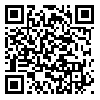Tue, Dec 16, 2025
[Archive]
Volume 12, Issue 36 (2020)
JMED 2020, 12(36): 41-50 |
Back to browse issues page
Download citation:
BibTeX | RIS | EndNote | Medlars | ProCite | Reference Manager | RefWorks
Send citation to:



BibTeX | RIS | EndNote | Medlars | ProCite | Reference Manager | RefWorks
Send citation to:
Lotfi A, Rezvani A, Ajam A A. Evaluation of the Role of Creative Educational Climate in Reflective Thinking Tendencies in Students of Qaen Nursing and Midwifery Faculty. JMED 2020; 12 (36) :41-50
URL: http://edujournal.zums.ac.ir/article-1-1207-en.html
URL: http://edujournal.zums.ac.ir/article-1-1207-en.html
1- Department of Educational Sciences, Payame Noor University, Iran
2- Department of Educational Sciences, Payame Noor University, Iran ,abolghasem.rezvani@gmail.com
2- Department of Educational Sciences, Payame Noor University, Iran ,
Abstract: (7877 Views)
Background & Objective: The main goal of research in the field of creative educational climate is to achieve results applied to persuade students to think freely, creatively, and critically. This study aimed to determine the role of a creative educational climate in reflective thinking tendencies in students.
Materials and Methods: This descriptive and correlational study was performed on all students studying in the school of nursing and midwifery of Qaen in the academic year of 2015-2016 (N=300). The sample size was estimated at 169 using the Krejcie and Morgan’s table and the participants were selected applying the stratified random sampling. Data were collected using Kember’s reflective thinking questionnaire (2000) and Ekvall’s creative climate scale (2013). Data analysis was performed in SPSS version 22 using independent t-test, Pearson’s correlation coefficient, analysis of variance, and regression.
Results: In this study, the total mean and standard deviation of creative educational climate and reflective thinking tendencies was reported to be 176.52±29.67 and 61.32±8.10, respectively. According to the results, there was a significant relationship between the components of creative educational climate and reflective thinking tendencies (P<0.01). Moreover, the components of the creative educational climate were able to predict students’ reflective thinking tendencies (P<0.000). On the other hand, no significant difference was observed between male and female students in terms of reflective thinking tendencies (P=0.711).
Conclusion: According to the results of the study, establishing a creative educational climate improves thinking and focus, thereby affecting reflective thinking tendencies. It is recommended that the components of a creative thinking climate by considered by professors to increase students’ participation in discussions. By doing so, they would play a considerable role in the use of strategies of reflective thinking tendencies. It is also suggested that a creative educational climate be considered in educational environments by educational planners.
Materials and Methods: This descriptive and correlational study was performed on all students studying in the school of nursing and midwifery of Qaen in the academic year of 2015-2016 (N=300). The sample size was estimated at 169 using the Krejcie and Morgan’s table and the participants were selected applying the stratified random sampling. Data were collected using Kember’s reflective thinking questionnaire (2000) and Ekvall’s creative climate scale (2013). Data analysis was performed in SPSS version 22 using independent t-test, Pearson’s correlation coefficient, analysis of variance, and regression.
Results: In this study, the total mean and standard deviation of creative educational climate and reflective thinking tendencies was reported to be 176.52±29.67 and 61.32±8.10, respectively. According to the results, there was a significant relationship between the components of creative educational climate and reflective thinking tendencies (P<0.01). Moreover, the components of the creative educational climate were able to predict students’ reflective thinking tendencies (P<0.000). On the other hand, no significant difference was observed between male and female students in terms of reflective thinking tendencies (P=0.711).
Conclusion: According to the results of the study, establishing a creative educational climate improves thinking and focus, thereby affecting reflective thinking tendencies. It is recommended that the components of a creative thinking climate by considered by professors to increase students’ participation in discussions. By doing so, they would play a considerable role in the use of strategies of reflective thinking tendencies. It is also suggested that a creative educational climate be considered in educational environments by educational planners.
Article Type : Orginal Research |
Subject:
Education
Received: 2019/08/25 | Accepted: 2020/02/21 | Published: 2020/06/24
Received: 2019/08/25 | Accepted: 2020/02/21 | Published: 2020/06/24
Send email to the article author
| Rights and permissions | |
 |
This work is licensed under a Creative Commons Attribution-NonCommercial 4.0 International License. |




